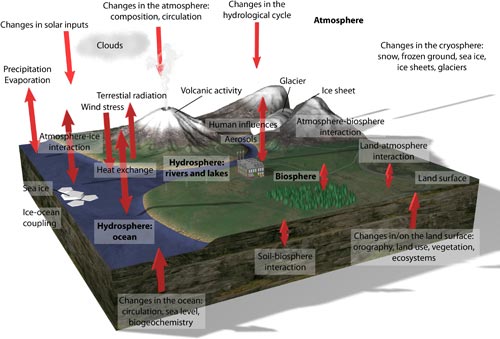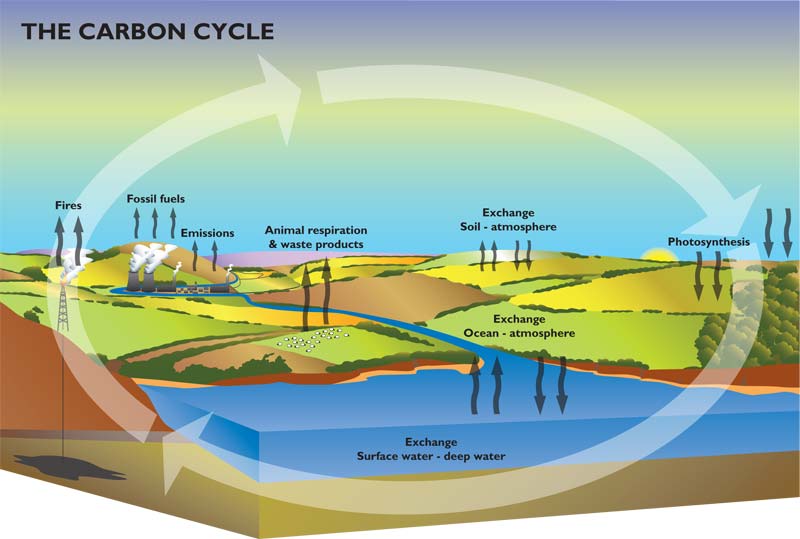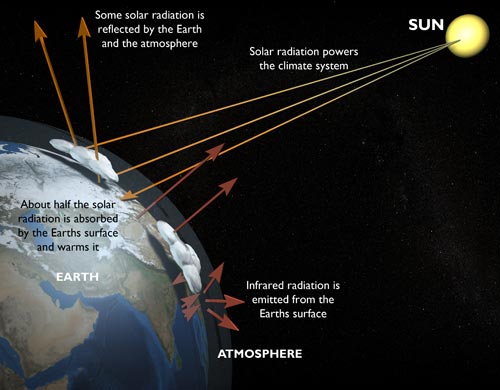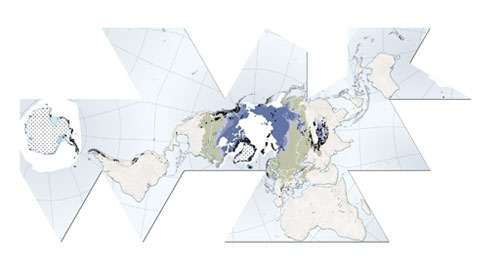The carbon story
What is climate and what is climate change?
‘Weather’ describes the combination of wind, rain, temperature and other natural atmospheric conditions we experience at a particular time and place.
Climate is the pattern of weather of an area averaged over many years.
So, if we have extremes in weather conditions, such as a long summer drought or a very cold winter, it doesn’t necessarily mean that the climate is changing.
We can only show whether or not climate change has occurred after decades of careful measurements and analysis.
The climate system
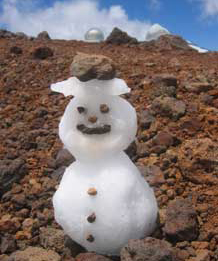
The climate system has many components that can alter. The effects of the alteration are often dependent on the operation of feedback mechanisms.
A feedback that enhances an initial change in climate is positive, but those that decrease the size of the change are negative.
For example, if the amount of solar energy absorbed on the Earth’s surface were to increase, then the surface temperature would increase.
This, in turn, would lead to a decrease in the amount of snow cover. As snow reflects more solar energy than land, vegetation or water, a decrease in the amount of land covered by snow would allow more solar radiation to be absorbed and so a positive feedback is initiated.
Carbon
Carbon is a crucial element for all life on Earth. It is also present in plants and rocks, the atmosphere and the oceans.
Carbon therefore moves, or ‘cycles’, between each of these things and is redistributed between carbon dioxide ‘sources’ and ‘sinks'.
Carbon is an interesting chemical because we don’t always know where these sinks and sources are!
The carbon cycle
The carbon in the carbon cycle may be either ‘organic’ or ‘inorganic’. The majority of the inorganic carbon exists as carbon dioxide, carbonate and hydrogen carbonate.
Organic carbon is that found in living or dead organisms, fossil fuels, small deposits in rocks, dissolved in water or dispersed in the atmosphere.
There is a continuous two-way flow of carbon between the organic and inorganic forms. Inorganic carbon is in an oxidised state which is reduced to organic carbon during photosynthesis.
Organic carbon is in a reduced state so it can be easily oxidised by atmospheric oxygen, this can happen in the absence of living organisms but usually living organisms are involved, in which case the process is called respiration.
The energy released during respiration is used both by plants and animals to maintain their bodily functions. A similar process in which oxygen is cycled between the atmosphere, the Earth and living organisms is interlinked with the carbon cycle, and photosynthesis and respiration are central to both.
More than 99 per cent of the carbon in the carbon cycle is found in the Earth’s crust in both organic and inorganic forms.
Carbon is added to, or removed from, this carbon ‘reservoir’ only slowly, so much of the carbon is essentially unavailable for cycling and has a long residence time.
Most of the carbon in the crust has a biological origin, deposited on the ocean floor from the remains of the many marine organisms that use calcium carbonate in their skeletons. After consolidation, these deposits may be formed into limestone rocks.
Carbon dioxide levels in the atmosphere

Carbon dioxide levels in the atmosphere depend on a balance (equilibrium) between carbon dioxide sources and sinks: sources give out carbon dioxide and sinks absorb and store carbon.
Geological sources of atmospheric carbon dioxide are volcanism, escaped gases from the Earth’s mantle and the erosion of rocks containing hydrocarbons such as oil.
Geological sinks include the erosion of silicate rocks, a process which tends to remove carbon dioxide from the atmosphere.
So volcanoes increase carbon dioxide in the atmosphere, whereas the erosion of mountain ranges reduces it.
Volcanism was much greater during the middle part of the Cretaceous Period, around 100 million years ago, and so this is why carbon dioxide levels in the atmosphere were much higher, which produced a much warmer climate.
The greenhouse effect
Greenhouse gases are actually crucial to keeping our planet at a habitable temperature, without them, the Earth would be about -17°C. Anthropogenic or human release of carbon dioxide contributes to the current enhanced greenhouse effect.
A greenhouse gas is so called because it absorbs infrared radiation emitted by the Earth’s surface (this radiation originally came from solar radiation), in the form of heat, which is circulated in the atmosphere and eventually lost to space.
Greenhouse gases also increase the rate at which the atmosphere can absorb short-wave radiation from the sun, but this has a much weaker effect on global temperatures.
Greenhouse gases in our atmosphere are:
- carbon dioxide
- water vapour
- methane
- nitrous oxide
- ozone
- CFCs
Methane hydrates
Methane is composed of carbon and hydrogen and is actually a much more powerful greenhouse gas than carbon dioxide but is less concentrated in the atmosphere.
Inside methane hydrates (or ‘clathrates’) the methane molecules are enclosed in a ‘cage’ of water molecules. This structure allows the methane molecules to be held much closer together than if they were in their gaseous form which means that solid methane hydrate can potentially hold a lot of methane gas.
There is a large quantity of methane below the sea floor and in permafrost soils. Methane in these reservoirs can potentially be released by such things as temperature changes in the deep oceans and on land, or by disturbing the sediment as a result of submarine landslides.
The amount of methane hydrate in permafrost soils is poorly known with some estimates ranging from 7.5 to 400 gigatonnes of carbon. If all of this methane hydrate were to melt, there could be catastrophic changes to our climate.
